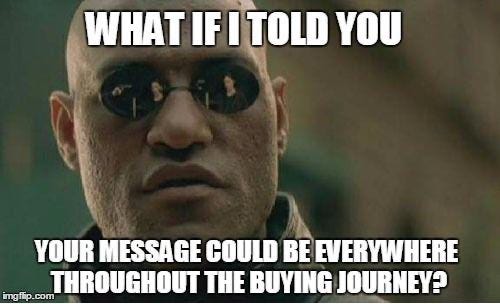From Series A to Exit: Mastering Metrics
2/9: Marketing
8 Min Read – What You’ll Take Away
Align Marketing and Sales on one goal - new ARR growth.
Fix messy messaging - clarity converts.
Invest in credibility - brand recognition shortens Sales cycles.
Rethink events - small, high-value activations outperform trade shows.
Adapt to AI search - thought leadership wins rankings.
Leverage micro-influencers - trusted voices drive engagement.
Shift from demand capture to demand generation - own the conversation.
From Series A to Exit: Mastering Metrics
Despite what you may think, the recipe for reaching your next financial milestone doesn’t have to be a black box. In “From Series A to Exit: Mastering Metrics”, we break down what it takes to position your business as an attractive investment - be it for funding or a strategic exit. Each article in this series will focus on a core function critical to your success:
GTM: Marketing,
and People.
In addition to my own experience, my co-authors draw on their success stories from the likes of Uber, Booking, Dropbox, LinkedIn, Just Eat Takeaway, Lightspeed, Miro, EasyPark, Bynder, Squarespace, BlackRock, JP Morgan, Ares, and more.
Go-To-Market: Mastering Marketing Metrics
Most founders and investors I talk to struggle - at some point - with either one of the below:
Marketing isn’t generating enough high-quality leads.
Their customer acquisition costs (CAC) don’t scale efficiently over time. They’ve picked all low-hanging fruits - now acquisition is getting harder and more expensive.
You might get to EUR 1M ARR by burning VC funds on paid acquisition. At EUR 10M ARR, that no longer works. Scaling (cost-)efficiently requires a shift from just capturing demand to creating it.
Investors and buyers also aren’t just looking at today’s CAC - they want to see unit economics improve over time. If your CAC/ LTV ratio isn’t trending in the right direction, it’s an indication your growth model won’t scale.
So how do we keep your GTM from coming to a grinding halt? In today’s deep dive I’m joined by Julie Zabinski and Sebastiaan Smits - Marketing leaders with extensive experience in globally scaling SaaS and platform businesses.
Julie - a Marketing strategist with over a decade of GTM experience - has helped industry leaders like Squarespace, Lightspeed, HelloFresh, and Treatwell successfully enter new markets across Europe. She specializes in market entry strategies and brand positioning - ensuring a direct link between brand and revenue growth.
Sebastiaan has led GTM teams at Lightspeed, Orderchamp, and Whoppah before becoming a fractional Marketing Lead at Omnia Retail and Dialog (Visma). He has an extensive record of building and scaling demand generation engines paving the way for multiple funding rounds and successful exits.
Together, we’ll unpack:
A. The most common Marketing mistakes killing lead volume and quality,
B. Quick wins that pack an immediate punch,
C. Long-term opportunities to build a high-performing demand engine at scale.
A. Marketing Mistakes Killing Your Growth
1. You’re Tracking the Wrong Metrics
Annual goal setting always feels like a marketplace hustle - a strategic game of self-preservation with everyone angling for metrics they know they can hit. Vanity metrics (traffic, social media followers, CPL) are easy to chase but mean nothing if they don’t translate to revenue. Give in too much and you’ll create silos where people default to old habits.
“Many Marketing teams track vanity metrics - website traffic, social media followers, CPL - without tying them to actual revenue. That’s why so many campaigns look successful on paper but fail to drive true business."
Sebastiaan Smits
Sales and Marketing rarely make for a love-story either. Usually, Sales is blaming Marketing for sub-par quality leads, while Marketing points back for failing to convert them.
How To Fix It:
To get your Go-To-Market in shape, both teams need to perform a perfect dance - together. Despite inevitable pushback, you need to align both teams on the same goal: generating new business (new ARR).
Prioritize direct revenue impact: SQLs and funnel conversion over raw lead volume. In enterprise cycles, where Sales may already engage with MQLs, the job of Marketing doesn’t end there. Closing deals requires ongoing nurturing and engagement until the finish line.
“Marketing teams celebrate record lead numbers, while Sales struggles to close any of them. That’s the real disconnect." - Sebastiaan SmitsDon’t let rigidly budgeted CAC limits cost you opportunities: you’ll leave money on the table for all the wrong reasons. Monitor your CAC payback period - not just CAC as a static metric.
"We saw certain Google Ads campaigns driving higher-value buyers - but they were more expensive than our blended CAC goal. Instead of obsessively optimizing for the lowest CAC, we doubled spending on those high-LTV segments - and revenue followed."
- Sebastiaan Smits.
2. Your Messaging Is All Over The Place
Don’t mistake revenue for Go-To-Market Fit. I have yet to join an organization that’s already been tracking Reasons-for-Win (RFW) and could clearly show me why clients decided to sign on the dotted line.
It’s hard to believe, but I’ve seen EUR 5M+ ARR companies struggle to name even a single customer pain point. Ask your Product, Marketing, Sales, and Customer Success teams what your core value proposition is - you’ll get four different answers. Ask your customers and you’ll get yet another one.
“Hone your messaging: what are your USPs and how do you communicate them to prospects?”
Frederik Kersmaekers, o9 Solutions
When your teams aren’t aligned, neither is your messaging. And when your messaging is off, so is your revenue. Unless you clear the grit, your flywheel won’t spin - and you’ll be stuck wondering why growth feels so hard.
"When Marketing sells on ease of use but Sales pitches on price, you’ve got prospects confused."
Sebastiaan Smits
How To Fix It:
Organize annual alignment workshops with your leadership to streamline Vision and Mission: what opportunities do we see in our world and what’s our place in it?
Track Reasons-for-Win (RFW): don’t just report on your closed lost opportunities but understand why customers buy.
Refine ICP targeting: knowing your audience drives better messaging. Conduct competitive analyses, have Marketing speak to existing customers, shadow Sales calls, and read up on discovery call scripts. In order to know how and where to attract prospects, they need to get a feel for who your ICP is and what matters to them most. Even better if they understand where the product excels and where it falls short. Synthesize those insights with other customer-facing teams and share them with Product.
Marketing needs to own the domains of market research, messaging, and collateral to make sure you have one central point in the organization controlling your narrative.
3. You Don’t Invest in Brand
Rising costs and increasing tracking restrictions (think cookies, iOS privacy updates, and Facebook’s ad limitations) have made Demand Capture channels increasingly hard and expensive to exploit. It’s no longer enough to fully rely on paid advertisement channels hoping for top-of-funnel (TOFU) conversion - it’s about grabbing and holding attention.
First touchpoints need to stand out: be funny, insightful, or deeply relatable. Then connect that attention with a unique identifier about your brand (e.g. a unique color or slogan). Forget pushing product features too soon - at this stage, it’s solely about sparking interest. Real conversion happens further down the funnel (BOFU), where targeted content - solutions to pain points, pricing, and product specifics - becomes relevant and drives action.
“Branding isn’t just a top-of-funnel (TOFU) play. Being consistently visible, credible, and top of mind shortens Sales cycles.”
Julie Zabinski
That said, branding isn’t just a TOFU play - it’s a constant lubricant throughout your entire Sales cycle. Granted, it primarily grabs your audience’s attention, builds up an expectation around your company and product, and consequently provides a soft landing for Sales when reaching out for the first time. What most forget about, however, is the value of branding lower down the funnel: where multiple stakeholders get involved.
B2B buying decisions rarely rest on a single champion - they have to pass through multiple hidden buyer personas: the CFO, the board, the procurement team. With many of them experiencing their first touchpoint mid-funnel where your champion wants to talk features or pricing, it’s good branding, that ensures unfamiliar stakeholders already have a level of trust in what you do.
Branding also helps with AI search. Anyone asking ChatGPT for “the best” hammer for their nail, will get results ranking brands by popularity and most credibility in their space. Proper branding will create an inbound motion that doesn’t need much investment.
“Of course you should still push Demand Capture tactics like Google ads but you need to find the right mix.”
Sebastiaan Smits
All of that said, Demand Capture isn’t dead yet. It’s still a crucial pillar of your Go-To-Market strategy but rising ad fatigue, increasing competition, and soaring costs mean it’s no longer enough. To stay ahead, you need to expand your playbook and find more efficient ways to attract and convert prospects.
How To Fix It:
Run awareness ads with clear brand recognition: I prefer a mix of informational and funny content that evokes emotions within your target audience. You’re selling to people after all.
Invest in credibility and own your category: write white-papers and reports your CEO shares on LinkedIn. Use AI to re-purpose existing content but make sure the messaging is crystal clear and consistent.
Get your employees to start posting on LinkedIn: create a posting schedule, create content with AI, review it, and make sure it’s relevant for prospects.
Pro-Tip: “Capture leads by gating your content: ask your audience to comment “receive” to get access.” - Sebastiaan Smits
Making the point with a real-life example, the below comparison shows the shift from Convious’ old lead-gen-focused ads to a new attention-grabbing and Sales-enabling approach. The results? Exceptional dwell times - with our Ben Affleck ad averaging over 9 seconds. For context: typical LinkedIn ads barely hold attention for a second. This means users weren’t just pausing, they were actually engaging - a rare feat in an environment in which attention spans are notoriously short.
We further found funny content to drive the highest dwell times and impressions, while informational content delivered the most clicks (another hint for you to gate your high-value content). High engagement signals LinkedIn’s algorithm to amplify your reach - this eventually helped us land in front of all target accounts.
B. Quick Hacks With Immediate Impact
1. Improve a Weak Inbound Flow
If you’re getting traffic but it doesn’t convert, you’re not following the best practices: add CTAs within blogs, add lead forms to download a white-paper, and share gated recordings of a customer demo. Don’t let raw traffic numbers or seemingly low conversion mislead you either. External agencies love to highlight website traffic but they won’t tell you who those visitors actually are. Focus on driving the right traffic: qualified leads, not job seekers or people looking for a picnic blanket.
Fix your website: improve CTAs and landing pages - make conversion effortless.
"You have to make sure your website speaks the same language as your reps. Be clear about which pain-points you solve and use your customer cases as proof.” - Sebastiaan SmitsGate high-value conversion-driven content behind walls: repurpose and re-distribute existing content but make sure the messaging is clear.
"Write white-papers, blog posts, do research on your own data and share reports, host webinars. Turn them into a LinkedIn carousel, a webinar, an email campaign, and a report - then retarget the engaged audience.” - Sebastiaan SmitsPush your LinkedIn presence to drive higher-quality inbound leads.
2. Get Your Reviews in Order
With AI search on the rise, sites like Capterra, G2, and Trustpilot are becoming even more critical.
Build a strong review presence: it doesn’t just boost credibility, it directly impacts your visibility when buyers search for solutions.
3. Stop Wasting Budget on Low-Impact Initiatives
I’ve seen comparably small annual Marketing budgets carry over EUR 100k in waste. In one case, we burned nearly EUR 2k on an email signature tool - something Google offers out of the box. What might seem like peanuts, quickly adds up. At Parkmobile we ran pricey out-of-home campaigns with no clear ROI - all to upsell existing users in markets where we already held 80% market share. Sometimes, the best way to gauge an initiative’s value is to cut the spend and see if anyone notices.
"Many Marketing budgets are spent out of habit, not performance. If a channel isn’t proving its worth, cut it - fast.”
Sebastiaan Smits
Audit your marketing spend: identify underperforming or unnecessary channels and initiatives and reinvest where it’s working.
Optimize paid ads: instead of blindly scaling, double down on the campaigns driving high-LTV customers.
Dare to be different: just because your competitor is at an event doesn’t mean you should be. Instead, look at the success the dating app Feeld has had with posters and spray-painting side-walks.
C. The Biggest Growth Opportunities Right Now
1. High-Impact Events over Trade Shows
Many brands still burn money on sponsorships that offer nothing but logo visibility on a press wall. Instead, make sure you control the narrative and create real engagement.
“Industry fairs love to advertise visitor numbers, but how many real prospects did you meet? Instead, invite 50–100 high-value prospects to an exclusive event at a key customer’s site. You’ll have their full attention.”
Julie Zabinski
Don’t spend EUR 20K on a trade show booth where SDRs get drinks with one another. Reallocate that budget into hosting your own event or creating other high-value content.
”You control the narrative and have a much higher chance of meaningful engagement.” - Julie ZabinskiLeverage customer sites for credibility: have them share the feeling of working with you.
Repurpose your content for omnichannel event amplification.
"Your 100-person masterclass can become a report, a video series, or a LinkedIn campaign." - Julie Zabinski
2. The Rise of Industry Creators and Influencers
“The creator economy is booming but most B2B brands ignore it. In France alone, it’s worth EUR 6.8B in 2024 and growing at 21% annually.”
Julie Zabinski
Leverage (micro-)influencers in your industry.
"It’s not just about reach - it’s about trusted voices driving engagement. We’ve done masterclasses on Twitch with hundreds of attendants." - Julie ZabinskiBlend mass-reach with hyper-targeted activations.
"Pair influencer-led campaigns with deep, high-value workshops or content." - Julie ZabinskiHost small, high-impact masterclasses with credible industry influencers.
"Build thought leadership partnerships and collaborate with credible voices in your industry for built-in trust." - Julie Zabinski
3. AI Is Redefining B2B Search
AI search ranks the most credible, widely known brands first. That means your inbound success depends on trust and visibility - not just keywords.
Dominate conversations before your competitors do.
”If you’re not actively shaping the conversation in your space, your competitors will - and AI will reward them for it. The more you establish yourself as a trusted domain authority now, the harder it will be for others to catch up later.” - Sebastiaan Smits
Wrapping Up
This was it for today’s deep dive. Big thanks to Julie, Sebastiaan, and Frederik for their insights and many fruitful conversations throughout this writing process!
If you need support or have questions positioning yourself for fundraising or an exit, I’m happy to help you navigate these waters. With years of experience advising entrepreneurs and leading businesses through multiple successful exits, I bring a unique toolbelt with frameworks, strategies, and best practices.
Let’s connect and discuss how we can set you up for your next major milestone.
Coming Up…
The following 5 articles go into other core business areas and their most relevant metrics. Fueled with the insights of experts in their fields, they will help you get each business unit in shape for your next financial milestone.
Next week, we’ll dive into common Sales mistakes and talk about how to fix them. Looking at best practices and sharing some of my tools, we’ll make sure you turn Marketing traction into revenue.
Learn how to build a product infrastructure that not only supports your own growth but addresses concerns of potential buyers - like IP protection, ease of integration, and technical scalability. We’ll touch on the balance between visionary innovation and customer-driven iteration to strengthen Product-Market Fit, expand your TAM, and create stickiness that drives long-term growth.
Forging great customer relationships is just the beginning. Learn how to build true retention machines: understand and forecast churn triggers, drive stickiness through integration partnerships, and grow NRR drawing on proven land & expand strategies.
Your customers, product, or brand may trigger an appetite. But your financials can make or break any successful raise or sale. Learn how to optimize CAC payback, fine-tune your spend and unit economics, and maintain clean financials to ensure your numbers tell the right story. We’ll also find time to dive into critical profitability metrics like EBITDA Margin, CAC/ LTV, ARR/ FTE, and the Rule of 40.
Any business is only as great as the people who drive it forward. Learn how to expand and align your leadership team, attract the talent you need for your next phase, and retain key personnel critical to your success. We’ll explore how to evolve your organizational design, build a culture that thrives through growth and change, and prepare for the challenges of post-merger integration (PMI).





















